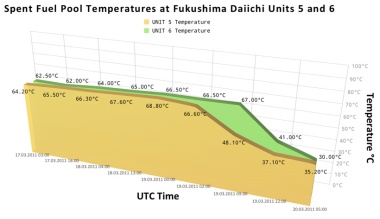The News Media's Curious Slant on the Fukushima Incident
As the situation at Japan's Fukushima Daiichi nuclear powerplant slowly winds down, the salient facts remain the same as they have been throughout: nobody has suffered or will suffer any radiological health consequences. Economic damage and inconvenience resulting from the quake's effects on nuclear power have been significant, but tiny in comparison to all other human activities – the nuclear power plants in the stricken region have suffered less damage and caused less trouble to local residents than anything else that was there.It is natural to be concerned about a disaster which might conceivably affect you or someone you care about. But intelligent people use such natural concerns as motivation to inform themselves on the facts. For a more balanced look at what is going on at the Fukushima reactors:
Despite this background, the details of which are now largely uncontested, hysteria continues to grip large sections of the news media and the internet. _Register
News roundup from Idaho Samizdat Nuclear Notes
A measured perspective on Fukushima from Brave New Climate
An interesting article published in The Atlantic suggesting that small modular nuclear reactors may receive a boost from higher level bureaucratic and political reaction to Fukushima. (H/T NEI Nuclear Notes)
The post-earthquake, post-tsunami incident at the Fukushima reactors is an economic and energy setback for the Japanese, as well as a public relations nightmare for the Japanese and the nuclear industry in general.
But the reason why the nuclear industry is being tarred so badly is because the world's media has focused its brightest lights on the reactors -- and decided to spew the most radioactively deceptive and misleading "reporting" as possible.
Yes, the world is becoming an Idiocracy -- it doesn't require a genius to see that. Corrupt and dysfunctional government school systems are not entirely to blame, either. Clearly the news and entertainment media play an even greater role in the education and informing of most citizens than the school systems, in the long run. If the media has chosen to dumb down and mislead the public, who will watch the watchers?
Am I saying not to worry about it, that nothing can go wrong? Just the opposite. I am saying to worry about it -- worry about everything. Worry so much that you are prepared for the worst that may come your way. Then hope for the best. Worry is just your brain's way of telling you to get off your lazy arse and learn what you need to learn, do what you need to do, and make whatever preparations you need to make.
No one should need to tell you to be very sceptical of anything you read or hear.
More on how the Fukushima incident may change the direction of the nuclear industry toward more "fail-safe" reactor designs.
Labels: Fukushima, media, nuclear energy, skankstream






















